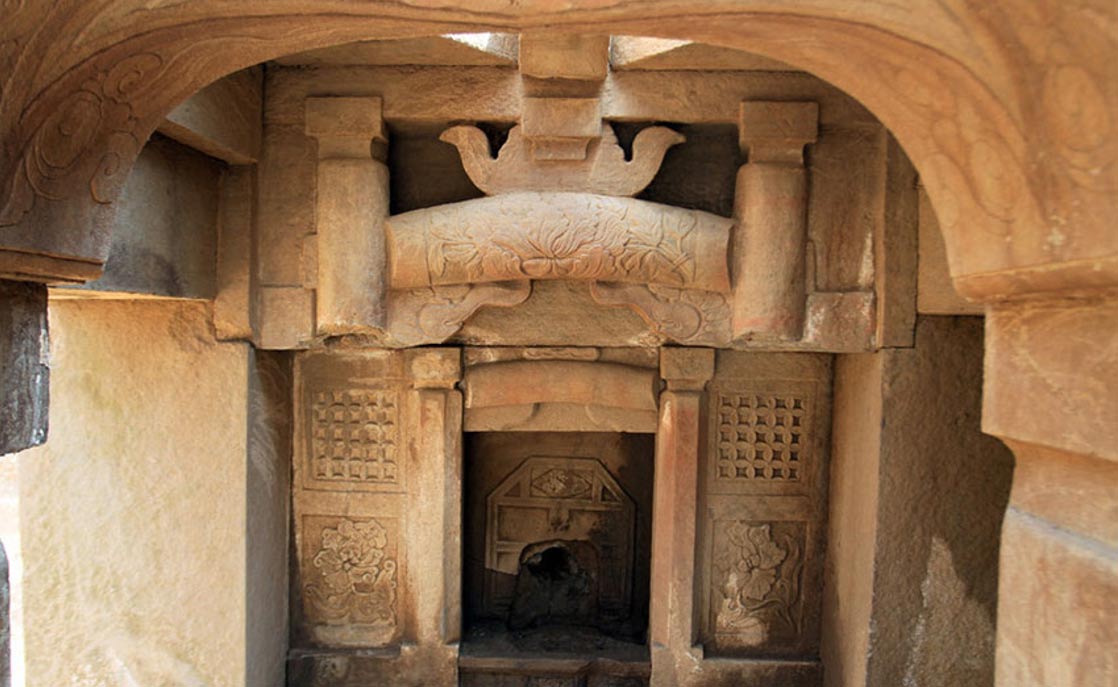Chinese Builders Discover Song Dynasty Tomb with Elaborate Decoration but Robbers Have Stolen the Rest
Researchers have recently investigated an ancient stone tomb in Baisha town of Jiangjin district which was originally discovered by builders of a Chinese secondary school. The site is in Chongqing, south west China and consists of an enormous tomb with a double burial chamber that may have been constructed during China’s Song Dynasty (960 - 1279AD). The tomb has been excavated by archaeologists from the Chongqing Municipal Academy of Cultural Heritage, who completed their field work on August 2nd.
Niu Yingbin, the lead archaeologist in charge of the excavation told the People’s Daily Online that a tomb of this size is extremely rare. He added that the entrance to the tomb was sealed by a large oval mound that may once have been surrounded by stone pillars, the remnants of which are at least 8 feet (2.4 meters) high. The tomb is located in the middle of the mound and incorporates a rectangular double burial chamber with alcoves in the walls measuring 8 feet (2.4 meters) in length, 25 feet (7.6 meters) wide and 10 feet (3 meters) high, making it equivalent to three single-deck buses parked alongside each other.
The tomb is entered by an entrance corridor and has two burial chambers connected by a central passage way. The walls of the chambers are decorated with intricate carvings which depict warriors, gods, children, animals and plants. Traces of red and black paint are still visible.
- The Longmen Grottoes and the largest collection of ancient art in China
- Nostradamus and Chinese Prophets Had Startlingly Similar Predictions
- Taosi Confirmed as 4,200-Year-Old Legendary Capital of Chinese Hero Emperor

One of the carvings at the tomb, Baisha town, Chongqing, China (China News Service/Zhong Xin)
“This type of tomb with the double burial chamber isn't unusual for the Song Dynasty” said Yingbin. “'But it's quite rare to find a tomb of this scale and complexity in the Chongqing area.”
The team of experts found broken ceramics in the tomb but nothing else. Yingbin said that this indicates the tomb had already been visited by tomb robbers. Just recently, 12 men were arrested on suspicion of raiding the tomb at Jiangjin, accused of stealing 1 million Yuan ($161,000) worth of artifacts, including two carved doors and a number of items buried within. One of the suspects is an antique dealer who confessed to keeping some of the items in his shop, selling other artifacts to other dealers.
Tomb robbers are a constant problem in China. Just recently, the tomb of Liu Yongfu, in the mountains of Qinzhou, was raided and desecrated. It was a protected national monument. Yongfu is a national hero to the Chinese. He fought in the Sino-French War of 1884 to 1885 and died in 1917.

General Liu Yongfu fighting the French in the Sino-French War. (1884) (Wikimedia Commons)
According to the archaeologists, the carvings indicate it was the tomb of someone of high social status. The Song Dynasty followed the Tang Dynasty, which ended in 960 AD due to at least half a century of conflict between rival kingdoms, as well as foreign invasions.
- Ancient Chinese artifacts found to have extremely rare iron compound
- Photographer captures last traces of the ancient tradition of foot binding
- Earliest ancient Chinese musical instruments unearthed in tomb complex
The Song Dynasty had two distinct phases – the Northern Song (960 to 1127) and the Southern Song (1127 to 1279). The Northern Song was a period of intense armed conflict between regional kingdoms, the last of which saw the capture of the emperor and most members of the royal family by the north western Liao Empire. The capital city of Kaifeng was also occupied. Survivors of the Song Clan moved to Hangzhou where they established a new capital. This was an age of peaceful prosperity as most of the wealthy trading cities were located south of the Huai River. Ships owned by Song Dynasty traders even managed to reach India and Arabia under the protection of a national navy. This was also a period of innovation with new inventions including gunpowder and mechanical clocks.

Painting entitled: Three laughing men by the Tiger stream. Depicting Lu Xiujing, Tao Hongjing and Huiyuan (founder of Pure Land). (12th Century) (Wikimedia Commons)
Most of the more well-known features of traditional Chinese culture, such as consumption of rice and tea-drinking, emerged during the Song Dynasty. In the Tang Dynasty that preceded it, most people ate wheat and millet and drank wine. The Chinese Confucianism tradition owes more to its reinvention during the Tang and Song Dynasties than it does to its origins. The ‘Chinese roof’ with ‘turned up corners’ is also a product of the Song Dynasty.

Close-up of daily life in Kaifeng from "Along the River During the Qingming Festival." (12th Century) (Wikimedia Commons)
Most tombs of the Song Dynasty are located in western Gongxian County in Henan Province. The Northern Song Dynasty’s main mausoleum is located there, about 130 miles (209.2 kilometers) north of the capital in Kaifeng. The area was known for its spectacular scenery and excellent soil which made it ideal for the construction of deep tombs and elaborate burial chambers. Each of the seven mausoleums in Gongxian County cover more than 8 hectares and feature a large tomb terrace.
Featured Image: Some of the beautiful carvings that have been found in the Song Dynasty tomb, Baisha town, Chongqing, China (Imagine China)



















